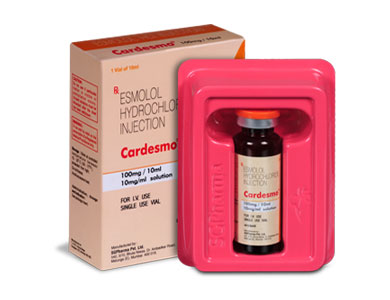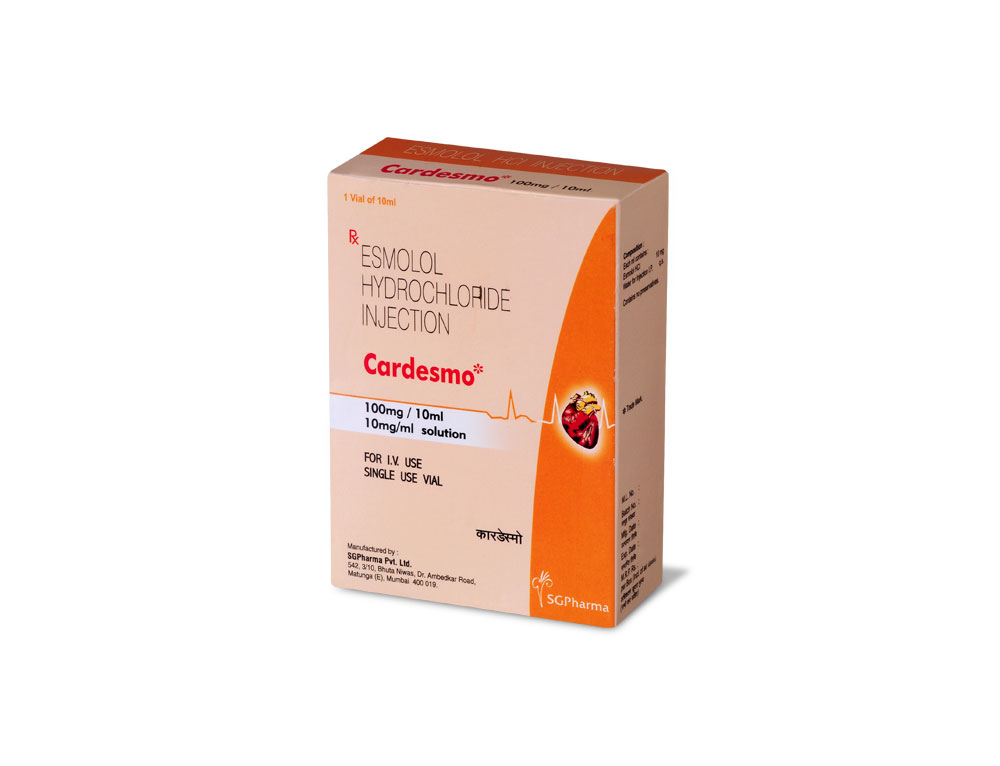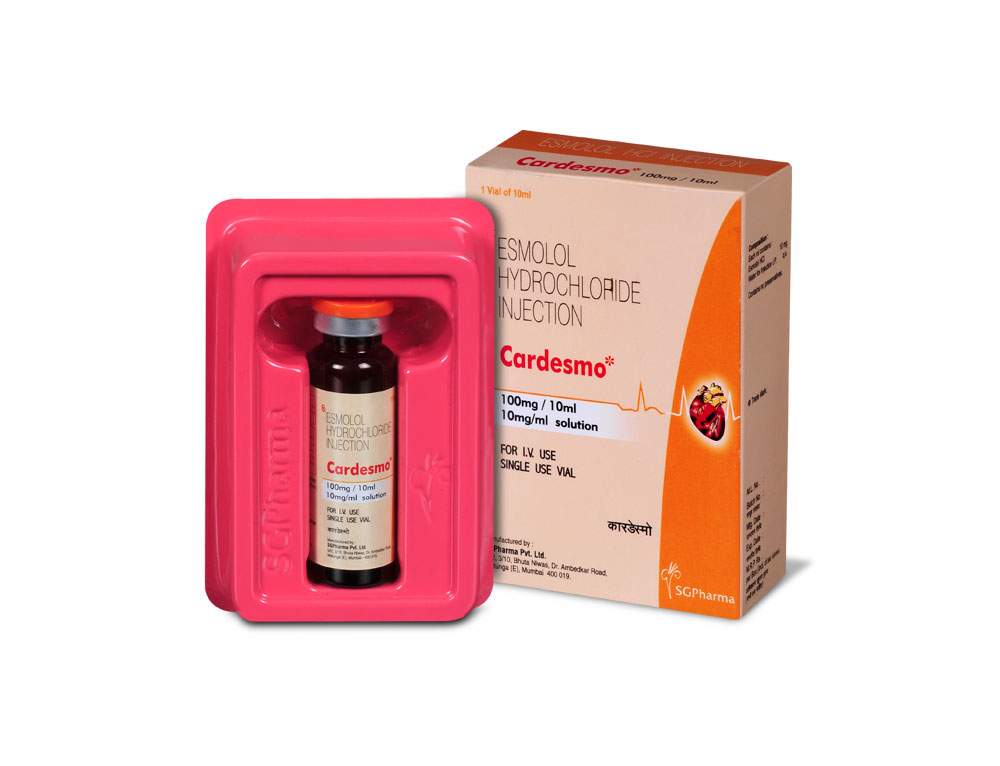
100 mg/10 ml, 2500 mg/10 ml
For the use of a Registered Medical Practitioner or a Hospital or a Institution only.
CARDESMO (Esmolol HCl) is a beta1-selective (cardioselective) adrenergic receptor blocking agent with a very short duration of action. Chemically, Esmolol HCl is designated as (±)-Methyl p-[2-hydroxy-3-(isopropylamino) propoxy] hydrocinna- mate hydrochloride. Its molecular formula is C16H26NO4CI and its molecular weight is 331.80.
STRUCTURAL FORMULA :
Its structural formula is :
![]()
CARDESMO is a sterile, clear, colourless to pale yellow solution filled in 10 ml vial.
COMPOSITION :
Each ml contains :
Esmolol HCl. 10 mg
Water for Injections I.P. q.s.
Contains no preservatives.
ACTIONS :
Esmolol HCl is a beta1-selective (cardioselective) adrenergic receptor blocking agent with rapid onset, a very short duration of action and no significant intrinsic sympathomimetic or membrane stabilising activity at therapeutic dosages. Its elimination half-life after intravenous infusion is approximately 9 minutes. Esmolol HCl inhibits the beta1 receptors located chiefly in cardiac muscle, but this preferential effect is not absolute and at higher doses it begins to inhibit beta2 receptors located chiefly in the bronchial and vascular musculature.
PHARMACOKINETICS :
Esmolol HCl is rapidly metabolised by hydrolysis of the ester linkage, chiefly by the esterases in the cytosol of red blood cells and not by plasma cholinesterases or red cell membrane acetylcholinesterase. Total body clearance in man was found to be about 20 L/kg/hr, which is greater than cardiac output; thus the metabolism of Esmolol HCl is not limited by the rate of blood flow to metabolising tissues such as the liver or affected by hepatic or renal blood flow. Esmolol Hydrochloride has a rapid distribution half-life of about 2 minutes and an elimination half-life of about 9 minutes. Using an appropriate loading dose, steady-state blood levels of Esmolol HCl for dosages from 50 - 300 mcg/kg/min (0.05 - 0.3 mg/kg/min) are obtained within 5 minutes. (Steady state is reached in about 30 minutes without the loading dose). Steady-state blood levels of Esmolol HCl increase linearly over this dosage range and elimination kinetics are dose-independent over this range. Steady-state blood levels are maintained during infusion but decrease rapidly after termination of the infusion. Because of its short half-life, blood levels of Esmolol HCl can be rapidly altered by increasing or decreasing the infusion rate and rapidly eliminated by discontinuing the infusion. Consistent with the high rate of blood-based metabolism of Esmolol HCl, less than 2 % of the medicine is excreted unchanged in the urine. Within 24 hours of the end of infusion, approximately 73 - 88 % of the dosage has been accounted for in the urine as the acid metabolite of Esmolol HCl.
Metabolism of Esmolol HCl results in the formation of the corresponding free acid and methanol. The acid metabolite has been shown in animals to have about 1/1500th the activity of Esmolol and in normal volunteers its blood levels do not correspond to the level of beta-blockade. The acid metabolite has an elimination half-life of about 3.7 hours and is excreted in the urine with a clearance approximately equivalent to the glomerular filtration rate. Excretion of the acid metabolite is significantly decreased in patients with renal disease, with the elimination half-life increased to about ten-fold that of normal and plasma levels considerably elevated. Methanol blood levels, monitored in subjects receiving Esmolol HCl for up to 6 hours at 300 mcg/kg/min (0.3 mg/kg/min) and 24 hours at 150 mcg/kg/min (0.15 mg/kg/min), approximated endogenous levels and were less than 2 % of levels usually associated with methanol toxicity.
Supraventricular Tachycardia :
In two multicentre, randomised, double-blind, controlled comparisons of Esmolol HCl with placebo and propranolol, maintenance doses of 50 to 300 mcg/kg/min (0.05 to 0.3 mg/kg/min) of Esmolol HCl were found to be more effective than placebo and about as effective as propranolol, 3 - 6 mg given by bolus injections, in the treatment of supraventicular tachycardia, principally atrial fibrillation & atrial flutter. The majority of these patients developed their arrhythmias postoperatively. About 60 - 70 % of the patients treated with Esmolol Hydrochloride had a desired therapeutic effect (either a 20 % reduction in heart rate, a decrease in heart rate to less than 100 bpm or, rarely, conversion to NSR) and about 95 % of those who responded did so at a dosage of 200 mcg/kg/min (0.2 mg/kg/min) or less. The average effective dosage of Esmolol HCl was approximately 100 - 115 mcg/kg/min (0.1 - 0.115 mg/kg/min) in the two studies. Other multicentre baseline-controlled studies gave essentially similar results. In the comparison with propranolol, about 50 % of patients in both the Esmolol HCl and propranolol groups were on concomitant digoxin. Response rates were slightly higher with both beta blockers in the digoxin-treated patients.
INDICATIONS :
Supraventricular Tachycardia :
CARDESMO is indicated for the rapid control of ventricular rate in patients with atrial fibrillation or atrial flutter in perioperative, postoperative or other emergent circumstances where short term control of ventricular rate with a short-acting agent is desirable. CARDESMO is also indicated in noncompensatory sinus tachycardia where, in the physician’s judgement, the rapid heart rate requires specific intervention. CARDESMO is not intended for use in chronic settings where transfer to another agent is anticipated.
Intraoperative and Postoperative Tachycardia and/or Hypertension :
CARDESMO is indicated for the treatment of tachycardia and hypertension that occur during induction and tracheal intubation, during surgery, on emergence from anaesthesia and in the postoperative period, when in the physician’s judgement such specific intervention is indicated. Use of CARDESMO to prevent such events is not recommended.
Administration :
Directions for use of the 10 ml ready-to-use vial (10 mg/ml) :
This dosage form is prediluted to provide a ready-to-use 10 mg/ml concentration recommended for CARDESMO intravenous administration. It may be used to administer the appropriate CARDESMO loading dosage infusions by hand-held syringe while the maintenance infusion is being prepared. When using the 100 mg vial, a loading dose of 0.5 mg/kg/min for a 70 kg patient would be 3.5 ml. CARDESMO should not be admixed with Sodium Bicarbonate. CARDESMO should not be mixed with other medicines prior to dilution in a suitable intravenous fluid.
Dosage :
Supraventricular Tachycardia :
In the treatment of supraventricular tachycardia, responses to CARDESMO usually (over 95 %) occur within the range of 50 to 200 mcg/kg/min (0.05 to 0.2 mg/kg/min). The average effective dosage is approximately 100 mcg/kg/min (0.1 mg/kg/min) although dosages as low as 25 mcg/kg/min (0.025 mg/kg/min) have been adequate in some patients. Dosage as high as 300 mcg/kg/min (0.3 mg/kg/min) have been used, but these provide little added effect and an increased rate of adverse effects and are not recommended. Dosage of CARDESMO in supraventricular tachycardia must be individualised by titration in which each step consists of a loading dosage followed by a maintenance dosage. To initiate treatment of a patient with supraventricular tachycardia, administer a loading infusion of 500 mcg/kg/min (0.5 mg/kg/min) of CARDESMO over 1 minute followed by a 4 minutes maintenance infusion of 50 mcg/kg/min (0.05 mg/kg/min). If an adequate therapeutic effect is observed over the 5 minutes of drug administration, maintain the maintenance infusion dosage with periodic adjustments up or down as needed. If an adequate therapeutic effect is not observed, the same loading dosage is repeated over 1 minute followed by an increased maintenance infusion rate of 100 mcg/kg/min (0.1 mg/kg/min).
In the event of an adverse reaction, the dosage of CARDESMO may be reduced or discontinued. If a local infusion site reaction develops, an alternative infusion site should be used and caution should be taken to prevent extravasation. The use of butterfly needles should be avoided. Abrupt cessation of CARDESMO in patients has not been reported to produce the withdrawal effects which may occur with abrupt withdrawal of beta-blockers following chronic use in coronary artery disease (CAD) patients. However caution should still be used in abruptly discontinuing infusions of CARDESMO in CAD patients. After achieving an adequate control of the heart rate and a stable clinical status in patients with supraventricular tachycardia, transition to alternative antiarrhythmic agents such as propranolol or digoxin may be accomplished. A recommended guideline for such a transition is given below but the physician should carefully consider the labelling instructions for the alternative agent selected :
| Alternative Agent | Dosage |
| Propranolol hydrochloride | 10 - 20 mg q 4 - 6 h |
| Digoxin | 0.125 - 0.5 mg q 6 h (p.o. or I.V.) |
The dosage of CARDESMO should be reduced as follows :
1. 30 minutes following the first dose of the alternative agent, reduce the infusion rate of CARDESMO by one-half (50 %).
2. Following the second dose of the alternative agent, monitor the patient’s response and if satisfactory control is maintained for the first hour, discontinue CARDESMO.
The use of infusions of CARDESMO up to 24 hours has been well documented; in addition, limited data from 24 - 48 hours (N = 48) indicate that CARDESMO Is well tolerated up to 48 hours. infusion of 50 mcg/kg/min. If an adequate therapeutic effect is not observed within 5 minutes, repeat the same loading dosage and follow with a maintenance infusion increased to 100 mcg/kg/min (see above, Supraventricular Tachycardia). Note : Higher dosages (250 - 300 mcg/kg/min) may be required for adequate control of blood pressure than those required for the treatment of atrial fibrillation, flutter and sinus tachycardia. One third of the postoperative hypertensive patients required these higher doses.
COMPATIBILITY WITH COMMONLY USED INTRAVENOUS FLUIDS :
Esmolol HCl Injection was tested for compatibility with ten commonly used intravenous fluids at a final concentration of 10 mg Esmolol HCl per ml. Esmolol HCl was found to be compatible with the following solutions and was stable for at least 24 hours at controlled room temperature or under refrigeration :
Dextrose (5 % ) Injection
Dextrose (5 %) in Lactated Ringer’s Injection
Dextrose (5 %) in Ringer’s Injection
Dextrose (5 %) and Sodium Chloride (0.45 %) Injection
Dextrose (5 %) and Sodium Chloride (0.9 %) Injection
Lactated Ringer’s Injection
Potassiuim Chloride (40 mEq/litre) in Dextrose (5 %) Injection
Sodium Chloride (0.45 %) Injection
Sodium Chloride (0.9 %) Injection
Esmolol HCl Injection was NOT compatible with Sodium Bicarbonate (5 %) Injection.
CONTRAINDICATIONS :
CARDESMO is contraindicated in patients with sinus bradycardia, heart block greater than first degree, cardiogenic shock, overt heart failure, bronchial asthma or other obstructive lung disease.
WARNINGS :
Hypotension :
In clinical trials 20 - 50 % of patients treated with Esmolol HCl have experienced hypotension, generally defined as systolic pressure less than 90 mmHg and/or diastolic pressure less than 50 mmHg. About 12 % of the patients have been symptomatic (mainly diaphoresis or dizziness). Hypotension can occur at any dose but is dose-related so that doses beyond 200 mcg/kg/min (0.2 mg/kg/min) are not recommended. Patients should be closely monitored, especially if pretreatment blood pressure is low. Decrease of dose or termination of infusion reverses hypotension, usually within 30 minutes.
Cardiac Failure :
Sympathetic stimulation is necessary in supporting circulatory function in congestive heart failure and beta blockade carries the potential hazard of further depressing myocardial contractility and precipitating more severe failure. Continued depression of the myocardium with beta blocking agents over a period of time can, in some cases, lead to cardiac failure. At the first sign or symptom of impending cardiac failure, CARDESMO should be withdrawn. Although withdrawal may be sufficient because of the short elimination half-life of CARDESMO, specific treatment may also be considered. The use of CARDESMO for control of ventricular response in patients with supraventricular arrhythmias should be undertaken with caution when the patient is compromised haemodynamically or is taking other drugs that decrease any or all of the following : peripheral resistance, myocardial filling, myocardial contractility, or electrical impulse propagation in the myocardium. Despite the rapid onset and offset of the effects of CARDESMO, several cases of death have been reported in complex clinical states where CARDESMO was presumably being used to control ventricular rate.
PRECAUTIONS :
Infusion concentrations of 20 mg/ml were associated with more serious venous irritation, including thrombophlebitis, than concentrations of 10 mg/ml. Extravasation of 20 mg/ml may lead to a serious local reaction and possible skin necrosis. Concentrations greater than 10 mg/ml or infusion into small veins or through a butterfly catheter should be avoided. Because the acid metabolite of CARDESMO is primarily excreted unchanged by the kidney, CARDESMO should be administered with caution to patients with impaired renal function. The elimination half-life of the acid metabolite was prolonged ten-fold and the plasma level was considerably elevated in patients with end-stage renal disease. Care should be taken in the intravenous administration of CARDESMO as sloughing of the skin and necrosis have been reported in association with infiltration and extravasation of intravenous infusions.
Use in Pregnancy :
Although there are no adequate and well-controlled studies in pregnant women, use of CARDESMO during labour and delivery has been reported to cause foetal bradycardia despite termination of drug infusion. CARDESMO should be used during pregnancy only if the potential benefit justifies the potential risk to the foetus.
Use in Lactation :
It is not known whether CARDESMO is excreted in human milk, however, caution should be exercised when CARDESMO is administered to a nursing woman.
INTERACTIONS :
Catecholamine-depleting medicines, e.g. reserpine, may have an additive effect when given with beta blocking agents. Patients treated concurrently with Esmolol HCl Injection and a catecholamine depletor should therefore be closely observed for evidence of hypotension or marked bradycardia, which may result in vertigo, syncope, or postural hypotension. A study of interaction between Esmolol and warfarin showed that concomitant administration of Esmolol and warfarin does not alter warfarin plasma levels. Esmolol concentrations were equivocally higher when given with warfarin, but this is not likely to be clinically important. When digoxin and Esmolol were concomitantly administered intravenously to normal volunteers, there was a 10 - 20 % increase in digoxin blood levels at some time points. Digoxin did not affect Esmolol pharmacokinetics. When intravenous morphine and Esmolol were concomitantly administered in normal subjects, no effect on morphine blood levels was seen, but Esmolol steady-state blood levels were increased by 46 % in the presence of morphine. No other pharmacokinetic parameters were changed. The effect of Esmolol on the duration of succinylcholine-induced neuromuscular blockade was studied in patients undergoing surgery. The onset of neuromuscular blockade by succinylcholine was unaffected by Esmolol, but the duration of neuromuscular blockade was prolonged from 5 minutes to 8 minutes. Although the interactions observed in these studies do not appear to be of major clinical importance, Esmolol HCl Injection should be titrated with caution in patients being treated concurrently with digoxin, morphine, succinylcholine or warfarin.
While taking beta blockers, patients with a history of severe anaphylactic reaction to a variety of allergens may be more reactive to repeated challenge, either accidental, diagnostic, or therapeutic. Such patients may be unresponsive to the usual doses of epinephrine used to treat allergic reaction. Caution should be exercised when considering the use of Esmolol and Verapamil in patients with depressed myocardial function. Fatal cardiac arrests have occurred in patients receiving both drugs. Additionally, Esmolol should not be used to control supraventricular tachycardia in the presence of agents which are vasoconstrictive and inotropic such as Dopamine, Epinephrine and Norepinephrine because of the danger of blocking cardiac contractility when systemic vascular resistance is high.
SIDE EFFECTS :
The following adverse reaction rates are based on use of Esmolol HCl in clinical trials involving 369 patients with supraventricular tachycardia and over 600 intraoperative and postoperative patients enrolled in clinical trials. Most adverse effects observed in controlled clinical trial settings have been mild and transient. The most important adverse effect has been hypotension. Deaths have been reported in post-marketing experience occurring during complex clinical states where Esmolol HCl was presumably being used simply to control ventricular rate.
Cardiovascular :
Symptomatic hypotension (diaphoresis, dizziness) occurred in 12 % of patients and therapy was discontinued in about 11 %, about half of whom were symptomatic. Asymptomatic hypotension occurred in about 25 % of patients. Hypotension resolved during Esmolol HCl infusion in 63 % of these patients and within 30 minutes after discontinuation of infusion in 80 % of the remaining patients. Diaphoresis accompanied hypotension in 10 % of patients. Peripheral ischaemia occurred in approximately 1 % of patients. Pallor, flushing, bradycardia (heart rate less that 50 beats per minute), chest pain, syncope, pulmonary oedema and heart block have been reported in less than 1 % of patients. In two patients without supraventricular tachycardia but with serious coronary artery disease (post inferior myocardial infarction or unstable angina), severe bradycardia/sinus pause/asystole has developed, reversible in both cases with discontinuation of treatment.
Central Nervous System :
Dizziness has occurred in 3 % of patients; somnolence in 3 %, confusion, headache and agitation in about 2 % and fatigue in about 1 % of patients. Paraesthesia, asthenia, depression, abnormal thinking, anxiety, anorexia and lightheadedness were reported in less than 1% of patients. Seizures were also reported in less than 1 % of patients, with one death.
Respiratory :
Bronchospasm, wheezing, dyspnoea, nasal congestion, rhonchi and rales have each been reported in less than 1 % of patients.
Gastrointestinal :
Nausea was reported in 7 % of patients. Vomiting has occurred in about 1 % of patients. Dyspepsia, constipation, dry mouth and abdominal discomfort have each occurred in less than 1 % of patients. Taste perversion has also been reported.
Skin (Infusion Site) :
Infusion site reactions including inflammation and induration were reported in about 8 % of patients. Oedema, erythema, skin discolouration, burning at the infusion site, thrombophlebitis and local skin necrosis from extravasation have each occurred in less than 1 % of patients.

 Cardiovascular
Cardiovascular








